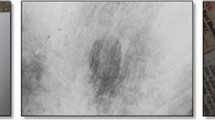Abstract
The performance of any fingerprint identification system depends on the accuracy of the feature extraction stage. Many latent fingerprint matching methods failed to produce good results because of the presence of background noise. To improve the performance, we propose a simple Deep Convolutional Neural Network (DCNN) model called ‘‘Minu-ExtractNet’’. Firstly, latent fingerprint pre-processing is implemented using a Convolutional Neural Network (CNN) model called ‘‘Pre-ProcessNet’’. This model enhances the quality of the latent and produces the orientation information along with different segmentation masks. Secondly, pre-processed information is then used to extract the minutiae feature points using another CNN model called ‘‘ExtractNet’’. This feature extractor model performs the image quality assessment to determine the threshold value to filter out spurious minutiae points. A dynamic thresholding algorithm is developed to achieve this goal. Experiments are carried out on both plain (FVC2004) and latent (NIST SD27) public fingerprint datasets. The results show significant improvement in precision, recall and Fl score values under different settings in comparison with the state-of-the-art CNN methods.
Access this chapter
Tax calculation will be finalised at checkout
Purchases are for personal use only
Similar content being viewed by others
References
Biometrics. http://biometrics.pbworks.com/w/page/14811357/FrontPage
Yoon,S., Feng, J., Jain, A.K.: Latent fingerprint enhancement via robust orientation field estimation. In: Proceedings of IEEE IJCB, pp. 1–8 (2011)
Jiang, L., Zhao, T., Bai, C., Yong, A., Wu, M.: A direct fingerprint minutiae extraction approach based on convolutional neural networks. In: Proceedings of IEEE IJCNN, pp. 571–578 (2016)
Tang, Y., Gao, F., Feng, J.: Latent fingerprint minutia extraction Using fully convolutional network. In: Proceedings of IEEE IJCB (2017)
Nguyen, Dinh-Luan., Cao, K., Jain, A.: Robust Minutiae Extractor: Integrating Deep Networks and Fingerprint Domain Knowledge. Michigan State University, East Lansing (2016)
Darlow, L., Rosman, B.: Fingerprint minutiae extraction using deep learning. In: Proceedings of IEEE IJCB (2017)
FVC2004. https://bias.csr.unibo.it/FVC2004/
Jain, A.K., Nandakumar, K., Ross, A.: 50 years of biometric research- accomplishments, challenges, and opportunities. Pattern Recogn. Lett 79, 80–105 (2016)
Wen, Y., Zhang, K., Li, Z., Qiao, Y.: A discriminative feature learning approach for deep face recognition. In: Leibe, B., Matas, J., Sebe, N., Welling, M. (eds.) ECCV 2016. LNCS, vol. 9911, pp. 499–515. Springer, Cham (2016). https://doi.org/10.1007/978-3-319-46478-7_31
Jain, A., Hong, L., Bolle, R.: On-line fingerprint verification. IEEE Trans. PAMI 19(4), 302–314 (1997)
Yang, X., Feng, J., Zhou, J.: Localized dictionaries-based orientation field estimation for latent fingerprints. IEEE Trans. PAMI 36(5), 955–969 (2014)
Watson, C.I., et al.: User's guide to NIST biometric image software (NBIS). NIST Interagency/Internal Report 7392 (2007)
Verifying. Neuro-technology (2010)
Feng, J.: Combining minutiae descriptors for fingerprint matching. Pattern Recogn. 41(1), 342–352 (2008)
Gao, X., Chen, X., Cao, J., Deng, Z., Liu, C., Feng, J.: A novel method of fingerprint minutiae extraction based on Gabor phase. In: Proceedings of 17th IEEE ICIP, pp. 3077–3080 (2010)
A. Sankaran, P. Pandey, M. Vatsa, and R. Singh: On latent fingerprint minutiae extraction using stacked denoising sparse autoencoders. In Proc. IEEE IJCB, pp.1–7, (2014).
Tang, Y., Gao, F., Feng, J., Liu, Y.: Fingernet- a unified deep network for fingerprint minutiae extraction. In: Proceedings of IEEE IJCB (2017)
Garris, M.D., McCabe, R.M.: NIST special database 27 - Fingerprint minutiae from latent and matching tenprint images. NIST Technical Report NISTIR 6534 (2000)
Author information
Authors and Affiliations
Corresponding author
Editor information
Editors and Affiliations
Rights and permissions
Copyright information
© 2021 Springer Nature Singapore Pte Ltd.
About this paper
Cite this paper
Deshpande, U.U., Malemath, V.S. (2021). MINU-EXTRACTNET: Automatic Latent Fingerprint Feature Extraction System Using Deep Convolutional Neural Network. In: Santosh, K.C., Gawali, B. (eds) Recent Trends in Image Processing and Pattern Recognition. RTIP2R 2020. Communications in Computer and Information Science, vol 1380. Springer, Singapore. https://doi.org/10.1007/978-981-16-0507-9_5
Download citation
DOI: https://doi.org/10.1007/978-981-16-0507-9_5
Published:
Publisher Name: Springer, Singapore
Print ISBN: 978-981-16-0506-2
Online ISBN: 978-981-16-0507-9
eBook Packages: Computer ScienceComputer Science (R0)




